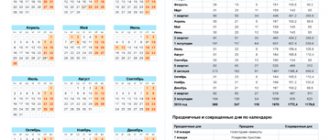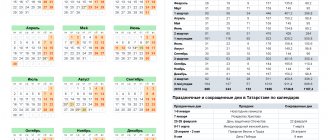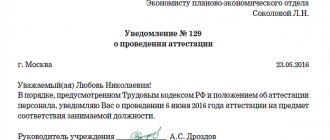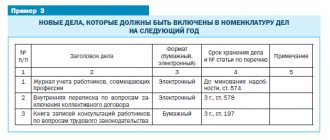Shift work as a type of employment according to the Labor Code of the Russian Federation
Having objective reasons, the employer can establish a shift work schedule for employees, which is permitted by Art.
103 Labor Code of the Russian Federation. As objective reasons, labor legislation names such criteria of the production process as:
- the length of the production cycle is greater than the maximum duration of daily work determined by law;
- intensification of the use of production equipment to increase the output of finished products.
Example
As an example, let us take the process of manufacturing products on a continuous cycle conveyor line. In this case, production equipment must operate around the clock, including Saturday and Sunday - traditional days off. This equipment loading mode creates the need for a similar work schedule for workers engaged in production. Thus, the described production process requires the introduction of a shift work schedule.
The shift work schedule involves the employment of groups of workers during the work process. Each group provides maintenance of the production cycle within normal working hours in accordance with the shift schedule.
Shift schedule, restrictions on its use
A shift schedule is a local regulatory act that determines the working conditions of workers who work in shifts. The development of this document, as well as its approval and mandatory communication to employees engaged in the work process on shift conditions, is the responsibility of the employer.
In Art. 103 of the Labor Code of the Russian Federation notes that, as a general rule, the shift schedule is part of the collective agreement, therefore, it must be agreed upon with the representative body of workers (Article 372 of the Labor Code of the Russian Federation). In the absence of a collective agreement and/or a representative body of employees, the shift schedule in the form of a separate legal act is approved by the manager.
The shift schedule must necessarily contain the essential conditions for working in shift mode:
- number of shifts during the accounting period;
- duration of working hours per shift, its start and end times;
- rest and meal breaks;
- daily and weekly rest time;
- shift rotation schedule.
When drawing up a shift schedule, labor law analysts suggest being guided by the current provisions of the Methodological Recommendations for organizing multi-shift work of production associations (enterprises) of industry, approved by the State Committee for Labor of the USSR (Moscow, 1988).
In the example above, it is logical and effective to use a shift schedule of 4 teams that work in the following mode: 3 teams provide work around the clock in 3 shifts of 8 hours each, the fourth has a rest.
IMPORTANT! If an employment contract with an employee contains a condition on shift work, the employer is obliged to notify him of the shift schedule for the next accounting period at least a month before the start of its validity (Article 103 of the Labor Code of the Russian Federation).
So, in our example, the shift schedule is a tool created by the employer to ensure a work cycle that is technologically longer than the maximum duration of daily work determined by law. This entails the need to work in the evening and night hours.
Labor legislation, protecting the rights of the employee, introduces certain restrictions on the use of labor in the evening and at night and, as, indeed, under any working time regime, requires an established ratio of work and rest time.
The Labor Code of the Russian Federation establishes the following restrictions:
- Art. 103 prohibits the involvement of 2 shifts in a row;
- Art. 96 prohibits the use of labor of pregnant women and workers under 18 years of age at night (according to the Labor Code of the Russian Federation, this is the period from 10 p.m. to 6 a.m.) and limits the possibility of using the labor of disabled people, persons with family responsibilities in relation to young children and other persons, requiring their written consent to work at night, provided that it is permitted by him for medical reasons.
Read about the specifics of organizing work at night in the material “Night work under the Labor Code (nuances).”
Calculation of average wages - formula, example and how to calculate vacation pay
Resolution of the Ministry of Labor of the Russian Federation of August 12, 2003 No. 62 “On approval of the procedure for calculating average earnings to determine the amount of unemployment benefits and scholarships paid to citizens during the period of professional training, retraining and advanced training in the direction of the employment service authorities” (hereinafter referred to as Procedure No. 62) .
This Procedure defines the rules for calculating average earnings for the following cases provided for by the Law of the Russian Federation of April 19, 1991 No. 1032-1 “On Employment of the Population in the Russian Federation” (hereinafter Law No. 1032-1):
- to determine the amount of unemployment benefits, including during the period of temporary incapacity for work of the unemployed and during the period of participation of the unemployed in public works (Article 33 of the Law of the Russian Federation No. 1032-1);
- to determine the amount of the scholarship during the period of professional training, advanced training, retraining as directed by the employment service, including during the period of temporary disability (Article 29 of Law No. 1032-1).
In accordance with paragraph 2 of Procedure No. 62, to calculate average earnings, all types of payments provided for by the remuneration system that are used in the relevant organization are taken into account, regardless of the sources of these payments, which include:
a) wages accrued to employees at tariff rates (official salaries) for time worked;
b) wages accrued to employees for work performed at piece rates;
c) wages accrued to employees for work performed as a percentage of revenue from sales of products (performance of work, provision of services), or commission;
d) wages paid in non-monetary form;
e) monetary remuneration accrued for time worked to persons holding government positions;
f) fees accrued in editorial offices of mass media and art organizations for employees on the payroll of these editorial offices and organizations, and (or) payment for their labor, carried out at the rates (rates) of author's (production) remuneration;
g) wages accrued to teachers of primary and secondary vocational education institutions for hours of teaching work in excess of the reduced annual teaching load (counted in the amount of one tenth for each month of the billing period, regardless of the time of accrual);
h) the difference in the official salaries of employees who transferred to a lower-paid job (position) while maintaining the amount of the official salary at the previous place of work (position);
i) wages, finally calculated at the end of the calendar year, determined by the remuneration system (taken into account in the amount of one twelfth for each month of the billing period, regardless of the time of accrual);
j) allowances and additional payments to tariff rates (official salaries) for professional excellence, class, qualification category (class rank, diplomatic rank), length of service (work experience), special conditions of civil service, academic degree, academic title, knowledge of a foreign language, working with information constituting state secrets, combining professions (positions), expanding service areas, increasing the volume of work performed, performing the duties of a temporarily absent employee without release from his main job, leading a team;
k) payments related to working conditions, including payments determined by regional regulation of wages (in the form of coefficients and percentage bonuses to wages), increased wages for hard work, work with harmful and (or) dangerous and other special conditions labor, for night work, payment for work on weekends and non-working holidays, payment for overtime work;
l) bonuses and remunerations, including remuneration based on the results of work for the year and a one-time remuneration for length of service.
When determining average earnings, bonuses and rewards actually accrued for the billing period are taken into account in the following order (clause 9 of Procedure No. 62):
- monthly bonuses and rewards - no more than one payment for the same indicators for each month of the billing period;
- bonuses and remunerations for a period of work exceeding one month - no more than one payment for the same indicators in the amount of the monthly part for each month of the billing period;
- remuneration based on the results of work for the year, a one-time remuneration for length of service (work experience), other remunerations based on the results of work for the year, accrued for the previous calendar year - in the amount of one twelfth for each month of the billing period, regardless of the time the remuneration was accrued.
If the time falling within the billing period is not fully worked or time is excluded from it in accordance with paragraph 4 of Procedure No. 62, bonuses and remunerations are taken into account when determining average earnings in proportion to the time worked in the billing period (with the exception of monthly bonuses paid along with wages for a given month).
If an employee has worked in an organization for an incomplete working period for which bonuses and rewards are accrued, and they were accrued in proportion to the time worked, they are taken into account when determining average earnings based on the amounts actually accrued in the manner established by this paragraph.
m) other types of payments in accordance with the existing remuneration systems in the organization.
This list is open, therefore payments not directly named in it, but provided for by the remuneration system, that is, enshrined in local regulations of organizations, are included in the payments taken into account for calculating average earnings.
It should be borne in mind that in order to calculate average earnings, payments to employees that are not related to wages (for example, dividends, insurance payments, financial assistance and other payments not related to the employee’s performance of a labor function) should not be taken into account.
Billing period.
The average employee’s earnings are calculated for the last 3 calendar months
(from the 1st to the 1st) preceding the month of dismissal (clause 3 of Procedure No. 62).
According to paragraph 4 of Procedure No. 62, when calculating average earnings, time is excluded from the calculation period, as well as amounts accrued during this time, if:
a) the employee retained his average earnings in accordance with the legislation of the Russian Federation;
b) the employee received temporary disability benefits or maternity benefits;
c) the employee did not work due to downtime due to the fault of the employer or for reasons beyond the control of the employer and employee;
d) the employee did not participate in the strike, but due to this strike he was not able to perform his work;
e) the employee was provided with additional paid days off to care for disabled children and people with disabilities since childhood;
f) the employee in other cases was released from work with full or partial retention of wages or without payment in accordance with the legislation of the Russian Federation;
g) the employee was provided with days of rest (time off) in connection with work beyond the normal working hours under the rotation method of organizing work and in other cases in accordance with the legislation of the Russian Federation.
The procedure for determining average earnings.
To determine the average earnings, the average daily earnings are used, determined in the manner specified in paragraph 7 of Procedure No. 62.
1) Calculate the average daily earnings by dividing the amount of wages actually accrued for the billing period by the number of days actually worked during this period.
2) Calculate the average employee’s earnings by multiplying the average daily earnings by the average monthly number of working days in the billing period (depending on the established length of the working week in the organization).
Example 1.
The employee, dismissed on September 10, 2004, contacted the organization with a request to provide a certificate of average earnings for the employment service. The billing period includes June, July, August 2004.
The employee's official salary is 5,000 rubles, the monthly bonus paid along with the salary is 1,000 rubles. At the same time, the employee worked in full in June and July, and was sick for three working days in August. Number of working days according to the 5-day working week schedule:
June – 21 days;
July – 22 days;
August – 22 days, of which 19 days were actually worked.
In August, the employee’s salary was 4318.18 rubles (5000: 22 x 19), the monthly bonus was 863.64 rubles (1000: 22 x 19).
According to paragraph 9 of the Procedure, if the billing period has not been fully worked out, bonuses and remunerations are taken into account when determining average earnings in proportion to the time worked in the billing period (with the exception of monthly bonuses paid along with wages for a given month).
1) Determine the average daily earnings:
(5000 rubles + 5000 rubles + 4318.18 rubles + 1000 rubles + 1000 rubles + 863.64 rubles): (21 + 22 + 19) = 277.13 rubles.
2) Determine the average earnings that must be indicated in the certificate submitted to the employment service authorities:
277.13 rubles x ((21 + 22 + 22) : 3) = 6004.48 rubles.
If during the billing period the employee did not have actually accrued wages or actually worked days, then the average earnings are determined based on the amount of wages actually accrued for the previous period of time equal to the calculated one (clause 5 of Procedure No. 62).
Example 2.
An employee, hired on May 12, 2004 and dismissed on September 10, 2004, contacted the organization with a request to provide a certificate of average earnings for the employment service. His official salary was 5,000 rubles. During this period, the employee:
From May 12 to May 31 - actually worked the days for which 3,889 rubles were accrued;
From June 1 to June 20 – was on a business trip;
From June 21 to July 20 – I was sick;
From July 21 to August 10 - was on leave without pay;
From August 11 to September 7 – was on a business trip;
From September 8 to September 10 - actually worked the days for which 682 rubles were accrued.
In this case, in the billing period (June, July, August), the employee did not actually have days worked and actually accrued wages, since periods of business trips, illness, and vacations are excluded from the calculation based on paragraph 4 of Procedure No. 62.
In accordance with paragraph 5 of Order No. 62, average earnings in this case are determined based on the amount of wages actually accrued for the previous period of time equal to the estimated one (March, April, May). Number of working days in this period according to the 5-day working week schedule:
March – 22nd day;
April – 22 days;
May – 18 days, of which 14 days were actually worked.
1) Determine the average daily earnings:
3889 rubles: 14 days. = 278 rubles.
2) Determine the average earnings that must be indicated in the certificate submitted to the employment service authorities:
278 rubles x ((22 + 22 + 18) : 3) = 5745 rubles.
If during the billing period and before the billing period the employee did not have actually accrued wages or actually worked days, then the average earnings are determined based on the amount of wages actually accrued for the days actually worked by the employee in the month of dismissal (clause 6 of Procedure No. 62).
Example 3.
An employee, hired on May 12, 2004 and dismissed on September 10, 2004, contacted the organization with a request to provide a certificate of average earnings for the employment service. His official salary was 5,000 rubles. During this period, the employee:
From May 12 to June 20 – was on a business trip;
From June 21 to July 20 – I was sick;
From July 21 to August 10 - was on leave without pay;
From August 11 to September 7 – was on a business trip;
From September 8 to September 10 – days actually worked, for which 682 rubles were accrued.
In this case, neither for the billing period (June, July, August) nor before the billing period (May) the employee had actually worked days and actually accrued wages, since periods of business trips, illness, vacation are excluded from the calculation based on paragraph 4 of the Procedure No. 62.
In accordance with paragraph 6 of Procedure No. 62, the average earnings in this case are determined based on the amount of accrued wages for the days actually worked in the month of dismissal.
1) Determine the average daily earnings:
682 rubles: 3 days = 227 rubles.
2) Determine the average earnings that must be indicated in the certificate submitted to the employment service authorities:
227 rubles x 22 = 4994 rubles, where 22 is the number of working days in September 2004.
End of the example.
When an employee is assigned part-time working time (part-time working week, part-time work), the average daily earnings are calculated by dividing the amount of actually accrued wages by the number of working days according to the calendar of a 5-day (6-day) working week falling on the time worked in billing period.
The procedure for determining average earnings with cumulative accounting of working hours.
To determine the average earnings of an employee for whom a summarized recording of working time is established, the average hourly earnings are used, which is regulated by paragraph 8 of Procedure No. 62.
1) Calculate average hourly earnings by dividing the amount of wages actually accrued for the billing period by the number of hours actually worked during this period.
2) Calculate the average employee’s earnings by multiplying the average hourly earnings by the average monthly number of working hours in the billing period (depending on the established length of the working week).
Example 4.
The employee, dismissed on September 10, 2004, contacted the organization with a request to provide a certificate of average earnings for the employment service. The billing period includes June, July, August 2004. The employee was provided with a summarized recording of working time.
Number of working hours according to the 40-hour workweek schedule:
June – 167 hours, of which 150 hours were worked and the salary was 4,500 rubles;
July - 176 hours, of which 140 hours were worked and the salary was 4,200 rubles;
August - 176 hours, of which 160 hours were worked and the salary was 4,600 rubles.
1) Let's determine the average hourly earnings:
(4500 rubles + 4200 rubles + 4600 rubles): (150 hours + 140 hours + 160 hours) = 29.56 rubles.
2) Determine the average earnings that must be indicated in the certificate submitted to the employment service authorities:
29.56 rubles x ((167 + 176 + 176) : 3) = 5113.88 rubles.
Calculation of average earnings when salaries increase.
In accordance with paragraph 10 of Procedure No. 62, when tariff rates (official salaries, monetary remuneration) increase in an organization (branch, structural unit), the average earnings of employees increase in the following order:
1) if the increase occurred during the billing period,
payments taken into account when determining average earnings and accrued for the period of time preceding the increase are increased by coefficients that are calculated by dividing the tariff rate (official salary, monetary remuneration) established in the month of occurrence of the event that is associated with maintaining average earnings by tariff rates ( official salaries, monetary remuneration) for each month of the billing period.
Example 5.
An employee dismissed on September 10, 2004 contacted the organization with a request to provide a certificate of average earnings for the employment service. The billing period (June, July, August 2004) has been fully worked out. In the structural unit of the organization (in which the dismissed employee was registered), from August 1, salaries were increased from 5,000 rubles to 6,200 rubles.
a) Let's determine the increase factor:
6200 rubles: 5000 rubles = 1.24 rubles.
b) Determine the average daily earnings:
((5000 rubles + 5000 rubles) x 1.24 + 6200 rubles): 65 days. = 286.15 rubles, where 65 is the number of days actually worked in the billing period;
c) Let us determine the average earnings that must be indicated in the certificate submitted to the employment service authorities:
286.15 rubles x (65 days: 3) = 6199.92 rubles;
2) if the increase occurred after the pay period before the day of dismissal,
The average earnings calculated for the billing period increase.
Example 6.
An employee dismissed on September 10, 2004 contacted the organization with a request to provide a certificate of average earnings for the employment service. The billing period (June, July, August 2004) has been fully worked out. In the structural unit of the organization (in which the dismissed employee was registered), from September 1, salaries were increased from 5,000 rubles to 6,200 rubles.
Standard hours for a shift work schedule, summarized recording of working hours
Labor legislation regulates the normal length of the working week - no more than 40 hours in the general case. A shortened week and a shorter duration of daily work are established by the Labor Code of the Russian Federation for certain groups of workers due to their age, health status, training, as well as employment at work with harmful or dangerous working conditions (Articles 92, 94 of the Labor Code of the Russian Federation). These standards are generally applicable, including for shift work.
As for harmful and dangerous working conditions, see the article “Dangerous and harmful production factors (list)” .
However, employers who practice shift work often find it difficult to adhere to the principle of a normal working week of no more than 40 hours. This is due to the specifics of the production process. In this case, Art. 94 of the Labor Code of the Russian Federation allows the employer to use summarized recording of working time.
Receive step-by-step instructions for introducing summarized working time tracking at your enterprise by signing up for a free trial access to the ConsultantPlus system.
When calculating hours worked, the base period is taken to be a month, quarter or year. This period for calculating the number of working hours is called accounting. The time spent by the employee on performing work duties in the accounting period should not exceed the normal number of hours of the working week, a multiple of the number of weeks.
Consequently, when using summarized working time tracking, 1 individual shift may differ in duration both up and down. But in general, the number of hours worked for the period of time accepted as an accounting period should not be more than established for this period, provided that the work hours are normal.
For the form for recording working time and the procedure for filling it out, see the article “Working time sheet - form T-13 (form)” .
The Labor Code of the Russian Federation limits the duration of the accounting period: it cannot be more than 1 year. The use of summarized working time recording affects the fundamental rights of the employee - to work and rest. That is why it must be formalized by a separate local legal act of the employer or a regulation on internal regulations.
Features of the month
It is October that is the “magical” center of autumn, which is followed practically by the beginning of winter, because already in November snow often falls and the first frosts begin, which have their own charm. We can consider this a transition month when the weather begins to change dramatically. Everything around becomes somewhat gloomy and cold. And, of course, it’s worth remembering that the autumn months are considered the most depressing, so you need to think today about how many days are left until October in order to have time to make good use of the warm and sunny days.
Autumn, I must say, is not the best time for a good rest, so all that remains is to work productively. However, you won’t be able to do without relaxing with friends and family, and for this you need to know how many days you will have to work during the month and how much you can rest.
How many working days are there in October?
The information about how many days we rest in October deserves special attention. It is known that this month there will not be as much rest as many would like. October consists of 31 days, and citizens will have to work for 23 days and rest for the remaining 8.
Since there are no official celebrations or important events, there will be no pre-holiday dates either, so you will have to enjoy the usual days off and wait for the winter holidays, which are planned only for the winter, to arrive.
Related news:
- Working days in August 2021 in Kazakhstan
- Disability pension and daily allowance in 2021
- Public holidays in Kazakhstan in 2021
- Production calendar 2021 for Kazakhstan
- Holiday calendar in Kazakhstan 2020-2021
- Latest news about the reorganization of the Russian Ministry of Emergency Situations in 2021
Results
Some production processes (continuous, technologically complex or with long production cycles) require the organization of work in shift mode. With a shift work schedule, it is difficult to maintain the normal working hours per working week (40 hours). Therefore, with such a labor regime, the Labor Code of the Russian Federation allows for the possibility of a different definition of the standard working time. This norm is established for a specific accounting period (month, quarter or year).
You can find practical solutions to complex payroll issues on our forum. For example, in this thread you can read about real-life examples and ask your own question.
Sources: Labor Code of the Russian Federation
You can find more complete information on the topic in ConsultantPlus. Free trial access to the system for 2 days.







